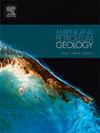Multistage selective diagenesis increasing poro-perm properties of Anisian sponge-microbial-coral patch reefs and adjacent facies in the Muschelkalk of Upper Silesia, Southern Poland
IF 3.7
2区 地球科学
Q1 GEOSCIENCES, MULTIDISCIPLINARY
引用次数: 0
Abstract
Carbonate rocks, particularly reefs and circum-reef facies, are significant reservoir rocks whose reservoir properties depend on their primary composition and diagenetic history. This paper reconstructs the influence of multistage selective diagenesis on the pore system evolution and porosity-permeability properties of the Anisian tropical reef system (Karchowice and Diplopora Beds) in the Muschelkalk of Upper Silesia, southern Poland, using field and slab observations, standard and cathodoluminescence petrography, bulk and SIMS carbon and oxygen stable isotope analyses, porosity-permeability plug study, and computer image analysis of macroporosity (>5 mm across). The reef system comprises two distinct levels of sponge-microbial(-coral) reef mounds surrounded by diverse bioclastic, peloidal, coated-grain, and micritic facies rich in Balanoglossites burrows. The strata experienced complex diagenetic alterations related to various fluids (marine, evaporitic, meteoric) and diagenetic environments (shallow substratal, burial, telogenetic), including (in chronological order): 1) early-marine precipitation of isopachous fibrous rims; 2) early dissolution during emersion; 3) brine-reflux dolomitization; 4) patchy silicification; 5) recrystallization; 6) burial calcite cementation by heated marine fluid; 7) deposition of vadose silt; 8) meteoric calcite cementation; 9) chemical compaction; 10) fracturing; and 11) final karstification, dedolomitization, FeO precipitation, and Liesegang ring formation by meteoric water during Cenozoic telogenesis. Many processes were selective and affected the same (more permeable) parts of the rocks. The strata exhibit porosities reaching 50% (combined plug porosity of 6–35% and macroporosity of up to 20%) and plug permeabilities of 0.07–70 mD, with the highest values occurring in the reefs and burrowed facies. The dominant late-stage telogenic dissolution pores originated from selective removal of dolomitized micrite within burrows and between sponge-microbial automicrite as well as dolomite crystals. The study illustrates the transition of the reef system from tight to porous due to multistage selective diagenesis and fluid flow, which enhanced subtle permeability differences between various types of micrite. This is the first case where four different fluids (dolomitizing, early dissolving, calcite-forming, and late dissolving) selectively migrated through the same rock parts at different times and modified them one after another.
多级选择性成岩作用增加了波兰南部上西里西亚穆谢尔卡尔克地区安尼西亚海绵-微生物-珊瑚斑块礁及邻近岩层的孔隙特性
碳酸盐岩,尤其是礁岩和环礁层,是重要的储层岩石,其储层性质取决于其原始成分和成岩历史。本文利用野外和板岩观测、标准和阴极发光岩石学、大量和 SIMS 碳和氧稳定同位素分析、孔隙度-渗透塞研究以及对大孔隙度(直径达 5 毫米)的计算机图像分析,重建了多级选择性成岩作用对波兰南部上西里西亚 Muschelkalk 地区 Anisian 热带礁岩系统(Karchowice 和 Diplopora 床)孔隙系统演化和孔隙度-渗透特性的影响;5 毫米宽)。礁石系统由两层不同的海绵-微生物(-珊瑚)礁丘组成,周围环绕着多种多样的生物碎屑岩、球状岩、涂布粒状岩和微粒岩层,富含巴拉诺格洛石洞穴。地层经历了与各种流体(海洋流体、蒸发流体、陨石流体)和成岩环境(浅底层、埋藏、远成岩)有关的复杂成岩变化,包括(按时间顺序排列):1)早期海洋沉淀:1)早期海相沉淀的等长纤维状边缘;2)浸润过程中的早期溶解;3)盐水回流白云石化;4)斑点状硅化;5)重结晶;6)埋藏中的方解石被加热的海相流体胶结;7) 沉积淤泥;8) 陨石方解石胶结;9) 化学压实;10) 断裂;以及 11) 新生代末期陨石水的最终岩溶化、反钙化、氧化铁沉淀和利斯冈环的形成。许多过程都是选择性的,并影响到岩石的相同(渗透性较强)部分。地层的孔隙率达到 50%(塞孔率为 6-35%,大孔隙率高达 20%),塞孔渗透率为 0.07-70 mD,最高值出现在礁岩和洞穴面。主要的晚期端生溶蚀孔隙源于洞穴内和海绵-微生物自动岩之间白云石化微晶以及白云石晶体的选择性去除。这项研究说明,由于多级选择性成岩作用和流体流动,珊瑚礁系统从致密过渡到多孔,从而加强了各类微晶岩之间微妙的渗透性差异。这是首次出现四种不同流体(白云石化流体、早期溶解流体、方解石形成流体和晚期溶解流体)在不同时期有选择性地流经同一岩石部分,并相继对其进行改造的情况。
本文章由计算机程序翻译,如有差异,请以英文原文为准。
求助全文
约1分钟内获得全文
求助全文
来源期刊

Marine and Petroleum Geology
地学-地球科学综合
CiteScore
8.80
自引率
14.30%
发文量
475
审稿时长
63 days
期刊介绍:
Marine and Petroleum Geology is the pre-eminent international forum for the exchange of multidisciplinary concepts, interpretations and techniques for all concerned with marine and petroleum geology in industry, government and academia. Rapid bimonthly publication allows early communications of papers or short communications to the geoscience community.
Marine and Petroleum Geology is essential reading for geologists, geophysicists and explorationists in industry, government and academia working in the following areas: marine geology; basin analysis and evaluation; organic geochemistry; reserve/resource estimation; seismic stratigraphy; thermal models of basic evolution; sedimentary geology; continental margins; geophysical interpretation; structural geology/tectonics; formation evaluation techniques; well logging.
 求助内容:
求助内容: 应助结果提醒方式:
应助结果提醒方式:


